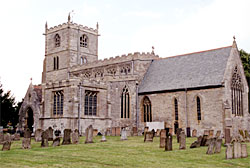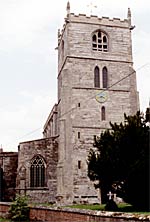The Vicarage of Norwell, which was re-established in 1284 after a vacancy of forty-eight years (see Liber Albus, p. 62), was in two medieties under the patronage of the prebendaries of Overhall and Tertia Pars respectively and though for long there were two Vicars the medieties are now united in one benefice. There was besides a chantry within the church with two chaplains, the advowson for which passed in 1375 from Nicholas Brett to Nicholas Dymock and from his descendants to Nicholas Coningston in 1412. I do not find particulars of this chantry in the Chantry Certificates of 1545-8 printed in our Society’s Transactions, and conclude that the foundation had lapsed before the Suppression, or perhaps it had been merged into one of the prebends, or was united with one of the chantries in Southwell Minster, as happened with another of the Norwell chantries, as we shall presently see. Of some of these absorptions of endowments no record was made, as they occurred in the processes of confiscation wholesale by Henry VIII., restoration or regrant by him to the Chapter of Southwell, re-confiscation in the next reign, and re-restoration by Queen Mary.

St Lawrence's Church, Norwell (© A P Nicholson, 2001).
The church at Norwell is now, and has been for some centuries, dedicated to St. Lawrence, but it would seem the previous dedication was to St. Andrew, for Curtis in his History of Nottinghamshire, p. 208, cites an Inq. ad quod Damnum stating that Robert Wodehouse, Archdeacon of Richmond, gave three messuages and lands here to the two chaplains in St Andrew’s Church, Norwell, and the Liber Albus at Southwell (p. 291) records that it was in the year 1340 that this Robert Wodehouse, who was then prebendary of Pallishall, founded this chantry and endowed it with the three messuages and lands in Norwell and Willoughby, of which the full schedule, with field-names, is set out (pp. 289, 290) in a survey of 1433. In 1341. (Liber Albus, p. 425) Roger of Bolton-upon-Dearne, who describes himself as chaplain and keeper of the chantries in the chapel of the Blessed Mary the Virgin in the south part of the parish church of St. Andrew of Northwell, with the consent of Robert de Wodehouse, Archdeacon of Richmond, founder of the said chantries, and of his colleague (confratris mel), Philip of Bathley, the other chaplain of the said chantries, complains that a messuage called Le Taunehale and twelve acres of land and three acres of meadow in Norwell were encumbered (onerantur) with the payment of twenty shillings a year rent to John Leveryke and his successors, chaplains serving in the chapel of St. John Baptist in the Church of Southwell. This entry is definite enough as to the dedication of the church and the position of the chapel of the Blessed Virgin Mary.
It is added that the document was placed for safe custody in the “pix” of the said chantry of St. John Baptist at Southwell—in cuius Cantarie pixide dicta indentura ponitur reservanda, et eadem indenture scribitur in Cantaria Henrici Vavosoure ad quam Cantariam pertinet magis quam ad istam.
In 1448 Wodehouse’s chantries at Norwell were entirely united with the
chantry of St. John Baptist at Southwell (Liber Albus, p. 428) though
as late as
The Robert Wodehouse mentioned was probably so called because born at Norwell Woodhouse, and he was Norwell’s most distinguished, parishioner. Besides being Prebendary of Pallishall, he became a Baron of the Exchequer in 1319, Archdeacon of Richmond in 1328, was summoned to Parliament in 1329 and 1337, and rose to be Treasurer of England in 1330. He died in 1345, and his will, which has been printed by the Surtees Soc. (Test: Ebor II., p. 13) was written in the chamber of his dwelling house at Norwell, and directs that his body should be buried in the choir of the Augustinians at Stamford under a marble stone there laid, and he leaves twenty pounds of silver for the expense of making his funeral. In view of the Dissolution we cannot but regret that he did not have his monument in this, his parish church.
To turn to this

Norwell Church tower. (© A P Nicholson, 2001)
The tower, which is of four stages, is Early English with lancet lights, the top stage possibly a little later. There is a north door to the nave with pointed head and a drip mould resting on heads, the westernmost of which appears to be that of a vowess wearing the wimple.
To come to the interior architecture, the south arcade of the nave comprises two transitional circular piers with foliated capitals and moulded bases, the western one spurred, and ends east and west with semicircular responds with coved octagonal caps. The piers carry steeply pointed arches of two orders with plain chamfers and without hood moulds. In the walling between the arches are three corbel heads, two of them expressive faces and the other a bear’s head, wearing his muzzle. These were probably the “stops” for the hood moulds which have disappeared, probably removed when the clerestory was added and they were no longer considered as requisite to take any drip from the underside of the eave of the Early English roof. Each western respond of the nave is backed by a piece of early walling acting as respond to the arches of the western bay, carried on short corbels of which the two next the tower show nail-head ornament. It would seem that the Early English tower was built outside the west end of the nave of the smaller Norman church, which was then lengthened one bay in order to join up with the tower.
The north nave arcade has two octagonal piers, the eastern one with fine bench base, which feature also occurs on the plain western pier—a square chamfered column with base stops, ogee shaped on eastern front and squinch pattern on western face.
The tower arch is of two orders with double chamfer and no hood mould, carried in semi-circular responds with fillet on face and two capitals with neck-moulds and coved moulding. The basement of the tower has western and southern lancet lights with deep splay, and a staircase at the north angle.
The original Early English roof has been removed and the nave heightened and lightened by a fine clerestory, the windows of which display a diagonal or lozenge-shaped tracery of uncommon occurrence.
The chancel, which is entered through a pointed arch supported on corbels, has an east window of five lights with geometric tracery and five good plain lancet windows with deep splays—three on the north and two in the south wall, the third and westernmost window of which is of the Perpendicular period. At the east end of the south wall is a low recess with semi-circular head and plain chamfer. I do not know whether it is ancient—the present stones at any rate bear modern tooling. On the south jamb of the chancel arch at the eye level is a tiny Latin cross with bulb-ended arms, not incised in the stone, but rather having the appearance of preservation by a hardened surface, possibly the effect of some former pigment.
.